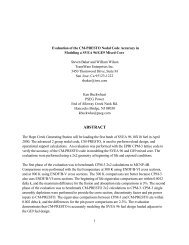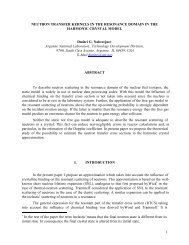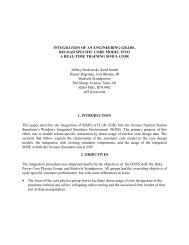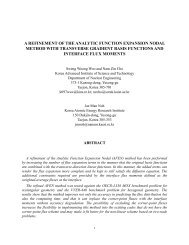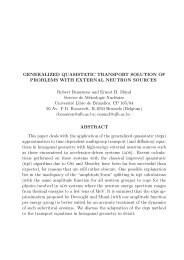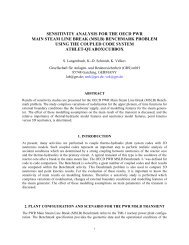Ellis
Ellis
Ellis
You also want an ePaper? Increase the reach of your titles
YUMPU automatically turns print PDFs into web optimized ePapers that Google loves.
of WG Pu in the form of MOX fuel. As part of FMDP physics support by ORNL, assessments<br />
were made of the Island and the full MOX LTA design options. The Island LTA design concept<br />
involved a VVER fuel assembly with either: a single central zone of MOX pins surrounded by<br />
UO2 pins, or a two-zone graded Pu-content MOX island surrounded by UO2 pins. For power<br />
peaking considerations, the two-zone graded Pu-content Island LTA design is the better of the<br />
two; the Island results discussed in this paper are only for the two-zone MOX Island LTA<br />
design. The full MOX LTA design discussed and assessed in this paper is a three-zone graded<br />
Pu-content MOX concept for the entire fuel assembly. The full MOX LTA design is the<br />
preferred and accepted design for further development and implementation.<br />
To illustrate the appearance and local environment of a full MOX LTA in a VVER-1000 reactor,<br />
Figure 1 shows a schematic diagram of the full MOX VVER LTA concept design. Standard<br />
LEU assemblies surround this MOX LTA; the three graded Pu-content MOX zones are seen in<br />
the diagram – these range from highest Pu-content in the center to lowest at the peripheral zone.<br />
Below, comparisons are shown between Russian TVS-M results and ORNL HELIOS results for<br />
the full MOX LTA design and some Island LTA results from a parametric optimization study are<br />
shown. The results of a detailed study of zero-power reactivity effects for temperature and<br />
coolant boron concentration are compared as a function of fuel burnup for the Island LTA, the<br />
full MOX LTA, and the standard LEU VVER fuel assembly.<br />
The issue of comparisons of void reactivity effects for LEU and MOX fuel are timely and of<br />
pertinence to discussions of Pu disposition. To complement the information shown and<br />
discussed concerning the reactivity behavior of VVER MOX LTA fuel, results from a scoping<br />
study of relative void reactivity effects in LEU, RG MOX and WG MOX fuel in PWR and<br />
VVER reactors are also presented below.<br />
2. MODELING DETAILS<br />
The VVER LTA model is based on a standard VVER-1000 assembly, in a multi-assembly<br />
structure: the MOX LTA is surrounded by LEU assemblies as shown in Figure 1. The fuel pins<br />
are positioned on a triangular lattice with a pitch of 1.275 cm. The assembly pitch is 23.6 cm.<br />
The fuel pins are made from fuel pellets of diameter 0.755 cm with a central hole of diameter<br />
0.15 cm. The fuel is surrounded by an air gap of 0.0085 cm and clad by zirconium alloy of<br />
thickness 0.069 cm. For the LTA calculations, a buckling (B 2 ) value of 0.0001 cm -2 was used to<br />
account for neutron leakage.<br />
The standard VVER K331 assembly has 331 sites of which 18 are guide tube thimble sites and<br />
there is one central instrument tube site. There are 312 sites available for fuel pins. In the full<br />
MOX LTA, the three MOX zones are 66 outer, 102 intermediate and 144 inner sites. In the twozone<br />
Island LTA, a central MOX zone of 24 sites is surrounded by a 30-site MOX zone, and this<br />
MOX island in turn is surrounded by 258 UO2 pins (3.7 wt% enriched). The reference uranium<br />
assembly referred to in Table I consist of 246 UO2 pins (3.7 wt% enriched) surrounded by a<br />
periphery of 66 UO2 pins (3.3 wt% enriched).<br />
2



